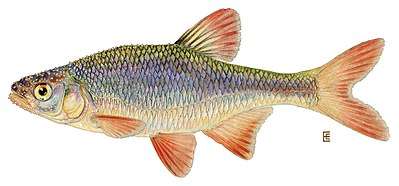Common shiner
The common shiner (Luxilus cornutus) is a freshwater fish of the family Cyprinidae, found in North America. It ranges in length between 4 and 6 inches, although they can reach lengths of up to 8 inches.[2]
| Common shiner | |
|---|---|
 | |
| Scientific classification | |
| Kingdom: | Animalia |
| Phylum: | Chordata |
| Class: | Actinopterygii |
| Order: | Cypriniformes |
| Family: | Cyprinidae |
| Subfamily: | Leuciscinae |
| Genus: | Luxilus |
| Species: | L. cornutus |
| Binomial name | |
| Luxilus cornutus (Mitchill, 1817) | |
| Synonyms | |
| |
Description
The common shiner is silvery colored (sometimes bronze) and has an "olive back with a dark dorsal stripe." [3]
The common shiner is a freshwater fish found in North America. Adults inhabit rocky pools in small to medium rivers. They can live to be approximately 6 years old.[4]
They are considered sexually mature by 7.4 cm. Breeding males have a pinkish tint over most of their body and small bumps or tubercles on their head.[5]
In comparison with Notropis, the common shiner's head, eyes, and mouth are large.[2]
Life History
The common shiner can be found in cool clear creeks and small to medium rivers, usually in the faster pools near riffles and in the shallow littoral of ponds and lakes.[3] Its preferred water temperature is 21.9 °C.
The common shiner reaches sexual maturity by 1–2 years of age, and produces between 400 and 4000 eggs per year. Common shiners spawn in spring between May and June, at temperatures of 16-26 °C. Common shiners often spawn over the nest of a creek chub, river chub, or fallfish, although some males will make their own small nests. Gravel in riffles is also possible.[2] Once the eggs are ready the male guards the nesting site.[3]
Common shiners are known to hybridize with other shiner species.[2]
Common shiners live for about 5–7 years.
Diet
The common shiner eats "terrestrial and aquatic insects, vegetation, and other fishes." [3]
Predators
Predators of the common shiner include fish (such as the smallmouth bass and chain pickerel) and birds (i.e. mergansers and kingfishers). [3]
References
- NatureServe (2015). "Luxilus cornutus". The IUCN Red List of Threatened Species. 2015: e.T202138A76572315. doi:10.2305/IUCN.UK.2015-1.RLTS.T202138A76572315.en.
- "Common Shiner (Notropis cornutus)". Archived from the original on 2008-05-04. Retrieved 2008-06-06.
- "Common Shiner". Retrieved 2008-06-06.
- "Common Shiner". Retrieved 2014-02-27.
- "Common Shiner". Retrieved 2014-02-27.
